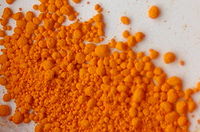Montroydite
 |
|
 |
|
| Names | |
|---|---|
|
IUPAC name
Mercury(II) oxide
|
|
| Other names | |
| Identifiers | |
|
3D model (Jmol)
|
|
| ChemSpider | |
| ECHA InfoCard | 100.040.580 |
| KEGG | |
|
PubChem CID
|
|
| RTECS number | OW8750000 |
| UN number | 1641 |
|
|
|
|
| Properties | |
| HgO | |
| Molar mass | 216.59 g·mol−1 |
| Appearance | Yellow or red solid |
| Odor | odorless |
| Density | 11.14 g/cm3 |
| Melting point | 500 °C (932 °F; 773 K) (decomposes) |
| 0.0053 g/100 mL (25 °C) 0.0395 g/100 mL (100 °C) |
|
| Solubility | insoluble in alcohol, ether, acetone, ammonia |
| Band gap | 2.2 eV |
| −44.0·10−6 cm3/mol | |
|
Refractive index (nD)
|
2.5 (550 nm) |
| Structure | |
| orthorhombic | |
| Thermochemistry | |
|
Std molar
entropy (S |
70 J·mol−1·K−1 |
|
Std enthalpy of
formation (ΔfH |
−90 kJ·mol−1 |
| Hazards | |
| Safety data sheet | ICSC 0981 |
|
EU classification (DSD) (outdated)
|
Very toxic (T+) Dangerous for the environment (N) |
| R-phrases (outdated) | R26/27/28, R33, R50/53 |
| S-phrases (outdated) | (S1/2), S13, S28, S45, S60, S61 |
| NFPA 704 | |
| Flash point | Non-flammable |
| Lethal dose or concentration (LD, LC): | |
|
LD50 (median dose)
|
18 mg/kg (oral, rat) |
| Related compounds | |
|
Other anions
|
Mercury sulfide Mercury selenide Mercury telluride |
|
Other cations
|
Zinc oxide Cadmium oxide |
|
Related compounds
|
Mercury(I) oxide |
|
Except where otherwise noted, data are given for materials in their standard state (at 25 °C [77 °F], 100 kPa).
|
|
|
|
|
| Infobox references | |
Mercury(II) oxide, also called mercuric oxide or simply mercury oxide, has a formula of HgO. It has a red or orange color. Mercury(II) oxide is a solid at room temperature and pressure. The mineral form montroydite is very rarely found.
In 1774, Joseph Priestley discovered that oxygen was released by heating mercuric oxide, although he did not identify the gas as oxygen (rather, Priestley called it "dephlogisticated air," as that was the paradigm that he was working under at the time).
The red form of HgO can be made by heating Hg in oxygen at roughly 350 °C, or by pyrolysis of Hg(NO3)2. The yellow form can be obtained by precipitation of aqueous Hg2+ with alkali. The difference in color is due to particle size, both forms have the same structure consisting of near linear O-Hg-O units linked in zigzag chains with an Hg-O-Hg angle of 108°.
Under atmospheric pressure mercuric oxide has two crystalline forms: one is called montroydite (orthorhombic, 2/m 2/m 2/m, Pnma), and the second is analogous to the sulfide mineral cinnabar (hexagonal, hP6, P3221); both are characterized by Hg-O chains. At pressures above 10 GPa both structures convert to a tetragonal form.
HgO is sometimes used in the production of mercury as it decomposes quite easily. When it decomposes, oxygen gas is generated.
It is also used as a material for cathodes for mercury batteries.
Mercury oxide is a toxic substance which can be absorbed into the body by inhalation of its aerosol, through the skin and by ingestion. The substance is irritating to the eyes, the skin and the respiratory tract and may have effects on the kidneys, resulting in kidney impairment. In the food chain important to humans, bioaccumulation takes place, specifically in aquatic organisms. The substance is banned as a pesticide in the EU.
...
Wikipedia

